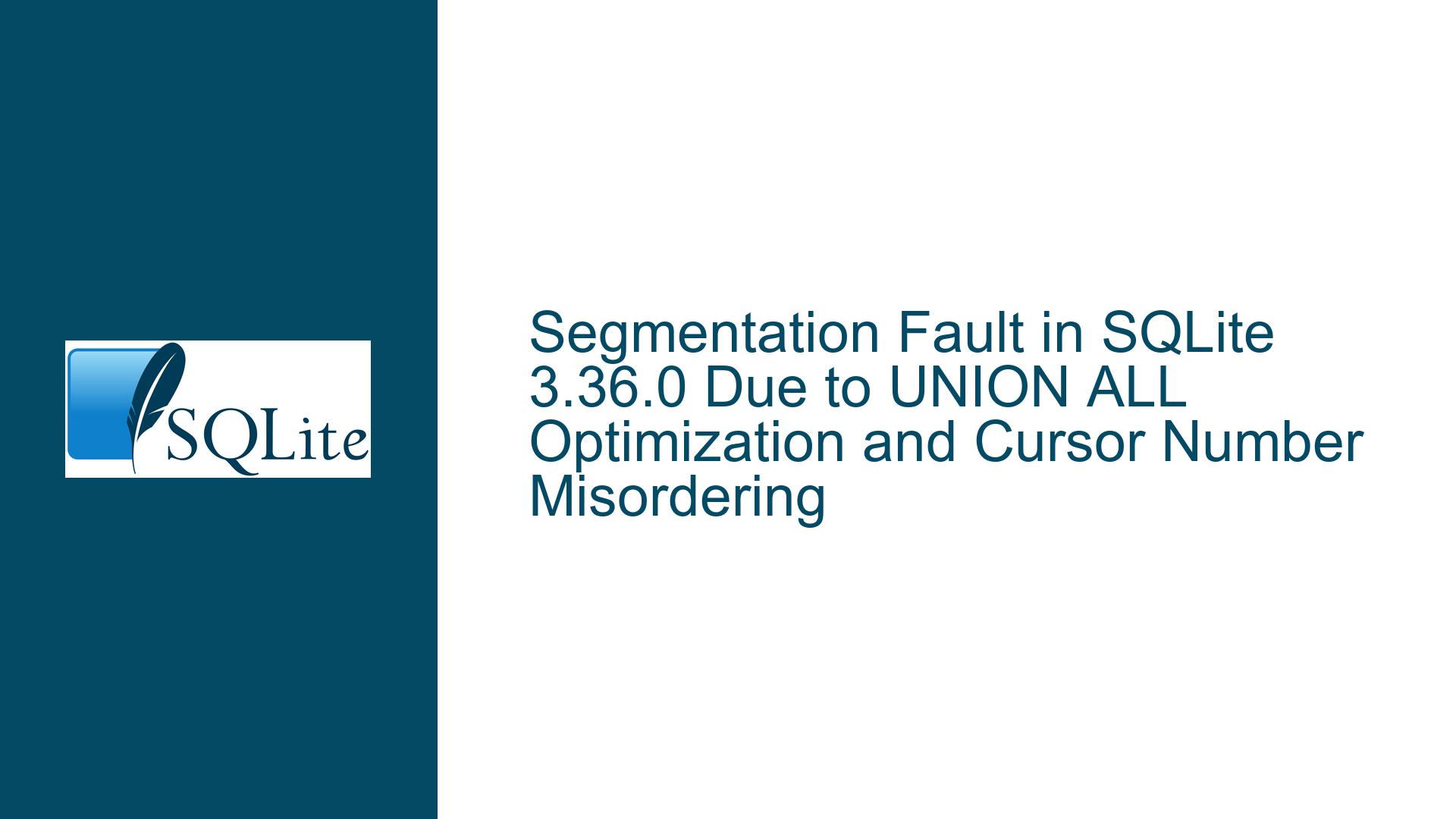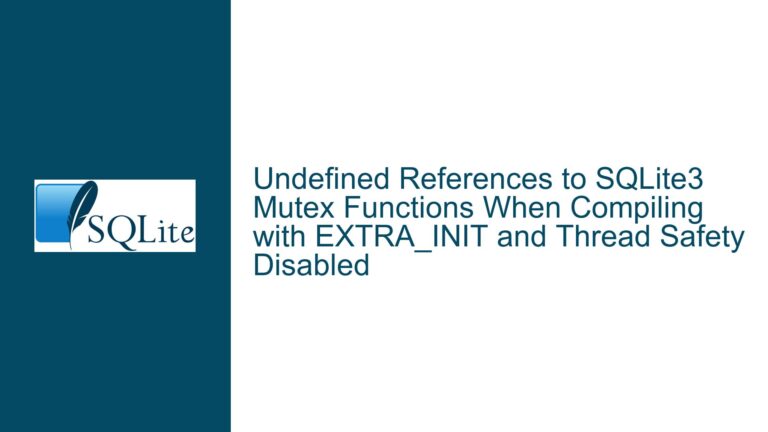Segmentation Fault in SQLite 3.36.0 Due to UNION ALL Optimization and Cursor Number Misordering
Issue Overview: Segmentation Fault in SQLite 3.36.0 Triggered by Complex Query with UNION ALL and Window Functions
The core issue revolves around a segmentation fault occurring in SQLite version 3.36.0 when executing a specific query involving a virtual table, a UNION ALL operation, and window functions. The fault manifests in two ways: as an assertion failure when SQLite is compiled with the --enable-debug option, and as a segmentation fault when the debug option is disabled. The problematic query combines a virtual table created using the rtree module, a UNION ALL operation, and a nested subquery with window functions and aggregate operations.
The segmentation fault is traced back to a NULL pointer dereference in the byte-code engine, which is caused by incorrect byte-code generation. The root cause lies in the misordering of cursor numbers during query optimization, specifically due to a UNION ALL optimization introduced in a prior SQLite version. This optimization inadvertently violates a critical assumption in SQLite’s name resolution logic: that cursor numbers for subqueries must always be greater than cursor numbers for outer queries. When this assumption is broken, the byte-code engine generates incorrect instructions, leading to the NULL pointer dereference and subsequent crash.
The issue is further complicated by the interaction between the UNION ALL optimization and the use of window functions (rank()) and aggregate functions (sum()). The query optimizer’s transformation of the original query into an optimized form results in a parse tree where cursor numbers are misordered, causing the byte-code engine to fail. This misordering is particularly problematic in nested queries involving correlated subqueries and window functions, as the cursor numbering logic becomes ambiguous.
Possible Causes: Misordered Cursor Numbers and Incorrect Byte-Code Generation Due to UNION ALL Optimization
The segmentation fault is primarily caused by the misordering of cursor numbers during the query optimization process. In SQLite, each table or subquery in a SELECT statement is assigned a unique cursor number. These cursor numbers are used by the byte-code engine to reference tables and subqueries during query execution. The name resolution logic for aggregate functions and window functions relies on a specific ordering of these cursor numbers: cursor numbers for subqueries must always be greater than cursor numbers for outer queries. This ordering ensures that the byte-code engine can correctly resolve references to tables and columns in nested queries.
The UNION ALL optimization, introduced in a prior SQLite version, disrupts this ordering. When the optimizer transforms a query involving UNION ALL, it may assign cursor numbers to subqueries that are smaller than the cursor numbers of outer queries. This misordering violates the assumption relied upon by the name resolution logic, leading to incorrect byte-code generation. The incorrect byte-code, in turn, causes the byte-code engine to dereference a NULL pointer, resulting in a segmentation fault.
The issue is exacerbated by the use of window functions and aggregate functions in nested subqueries. Window functions, such as rank(), introduce additional complexity to the query execution process, as they require the byte-code engine to maintain and reference state across multiple rows. When combined with aggregate functions, such as sum(), the byte-code engine must correctly resolve references to columns and tables in both the outer and inner queries. The misordering of cursor numbers disrupts this resolution process, leading to the generation of incorrect byte-code.
The problem is further compounded by the interaction between the UNION ALL optimization and the virtual table mechanism. Virtual tables, such as those created using the rtree module, introduce additional layers of complexity to the query execution process. The byte-code engine must correctly handle the unique characteristics of virtual tables, such as their custom indexing and search mechanisms. When the cursor numbers are misordered, the byte-code engine may fail to correctly reference the virtual table, leading to the segmentation fault.
Troubleshooting Steps, Solutions & Fixes: Refactoring Name Resolution Logic and Ensuring Correct Cursor Number Ordering
To address the segmentation fault, the SQLite development team implemented a refactoring of the name resolution logic for aggregate functions and window functions. The refactoring eliminates the dependency on the ordering of cursor numbers, ensuring that the byte-code engine can correctly resolve references to tables and columns in nested queries, regardless of the cursor number ordering. This solution is more targeted and requires fewer code modifications compared to enforcing a strict ordering of cursor numbers.
The refactoring involves the following key changes:
Refactoring the Name Resolution Logic: The name resolution logic for aggregate functions and window functions was refactored to remove the dependency on the ordering of cursor numbers. Instead of relying on the assumption that subquery cursor numbers are greater than outer query cursor numbers, the new logic uses a more robust mechanism to determine the correct query context for each function. This mechanism ensures that the byte-code engine can correctly resolve references to tables and columns, even when cursor numbers are misordered.
Eliminating the Need for Assertions: The original solution proposed adding assert() statements to check the ordering of cursor numbers during parse tree transformations. However, the refactored name resolution logic eliminates the need for these assertions, as the logic no longer depends on the cursor number ordering. This reduces the complexity of the code and minimizes the risk of future issues related to cursor number misordering.
Testing and Validation: The refactored logic was thoroughly tested using a variety of test cases, including the original query that triggered the segmentation fault. Additional test cases were generated to ensure that the refactoring did not introduce new issues or regressions. The testing process included both automated tests and manual verification to ensure the correctness and robustness of the solution.
Documentation and Code Comments: The refactored code was documented with detailed comments explaining the changes and the rationale behind them. This documentation ensures that future developers can understand the logic and make informed modifications if necessary. The comments also highlight the importance of maintaining the independence of the name resolution logic from cursor number ordering.
The refactoring was implemented in the SQLite source code and released as part of a subsequent version. The changes are reflected in the commit history, with the specific fix identified by the commit hash 74aec5dd1df95b56. Developers using SQLite 3.36.0 or later versions should ensure that they are using a version that includes this fix to avoid encountering the segmentation fault.
In addition to the refactoring, developers can take the following steps to troubleshoot and mitigate similar issues:
Review Query Optimization: When encountering segmentation faults or other unexpected behavior in SQLite, developers should review the query optimization process to identify potential issues with cursor number ordering. This review should include an analysis of the parse tree generated by the query optimizer and an examination of the byte-code generated by the byte-code engine.
Use Debug Builds: Compiling SQLite with the
--enable-debugoption can help identify issues related to incorrect byte-code generation. Debug builds include additional assertions and checks that can catch problems early in the development process. When a segmentation fault occurs, the debug build may provide more detailed information about the cause of the fault, such as the specific line of code where the fault occurred.Test with Simplified Queries: When troubleshooting complex queries, developers should create simplified versions of the query to isolate the issue. By removing unnecessary elements and focusing on the core components of the query, developers can more easily identify the root cause of the problem. In the case of the segmentation fault, simplifying the query to focus on the UNION ALL operation and the nested subqueries helped identify the cursor number misordering issue.
Monitor Query Performance: Segmentation faults and other issues may be related to query performance and resource usage. Developers should monitor the performance of their queries, particularly when using complex operations such as window functions and virtual tables. Performance issues may indicate underlying problems with the query execution process, such as incorrect byte-code generation or inefficient use of resources.
Stay Updated with SQLite Releases: SQLite is actively maintained, and new releases often include bug fixes and performance improvements. Developers should stay updated with the latest SQLite releases and apply updates as needed. When encountering issues, developers should check the SQLite release notes and commit history to determine if the issue has been addressed in a subsequent release.
By following these troubleshooting steps and applying the fixes implemented by the SQLite development team, developers can avoid segmentation faults and other issues related to cursor number misordering and incorrect byte-code generation. The refactoring of the name resolution logic provides a robust solution that ensures the correct execution of complex queries involving UNION ALL, window functions, and virtual tables.






